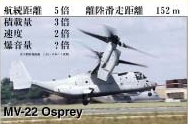Sunday April 9 9:59 AM ET
All 19 Dead in U.S. Marine Plane Crash
 PHOENIX, Ariz. (Reuters) - A Marine V22 Osprey, which takes off like a helicopter and flies like a plane, has crashed during a training mission in Arizona, killing all 19 troops aboard, U.S. military officials said.
PHOENIX, Ariz. (Reuters) - A Marine V22 Osprey, which takes off like a helicopter and flies like a plane, has crashed during a training mission in Arizona, killing all 19 troops aboard, U.S. military officials said.
The Osprey, with four crew members and 15 other Marines on board, crashed at about 8 p.m. PDT on Saturday (0300 GMT on Sunday) near Avra Valley Airport in the desert town of Marana, Arizona, said Pentagon spokesman Ken Bacon.
The airport is about 20 miles (32 km) northwest of Tucson, Arizona.
Defense Secretary William Cohen said that the Pentagon did not yet now what caused the crash.
``This is really hard to take in terms of 19 Marines dying on a training mission like this,'' added Cohen while on a plane from Kuwait to Saudi Arabia. ``It only points out how dangerous our training missions are, when we train with night vision capability equipment and that additionalburden opon those who are flying the aircraft.''
Bacon, who is travelling with Cohen, said the Marines were conducting training exercises when the crash occurred.
Marana residents told television news crews that the plane burst into a ball of flames before hitting the ground. Television pictures on CNN showed smoke rising from a smoldering mass of metal lit up by beams of light from emergency vehicles.
Military officials could not confirm, however, whether the plane had become an airborne fireball before it crashed.
The Osprey, under development for more than a decade, can take off and land like a helicopter using rotors before converting to fixed-wing operation that enables it to fly like a plane.
The Osprey is built by Bell Helicopter Textron Inc.
Capt. Rob Winchester, a U.S. Marine Corps spokesman at the Pentagon, said early on Sunday that the Marines were conducting final evaluations of the hybrid Osprey. It was not known whether the crash occurred while the plane was in transition from rotor-powered to fixed-wing flight, he said.
``Our concern goes out to the members of the families of those Marines on board,'' said Winchester.
The Osprey is due to be placed on full operational status in 18 to 24 months, Winchester said. It is designed to replace the helicopter as a means of getting U.S. troops in and out of hot spots quickly and in conducting civilian rescue operations.
The White House released a statement in which President Clinton underscored the dangers those in the military face even during peacetime.
``This terrible loss of life is a reminder of how so many men and women in the nation's military put their lives at risk, each and every day, so that we might be a free people, and the cause of peace can be advanced throughout the world.''
A second Osprey on the training mission was not involved in the accident.
Both planes were stationed at a Marine Corps air base in Yuma, Arizona, although the troops who perished were from around the United States, officials said.
No one on the ground was injured when the plane went down in fair weather.
There was no live ordnance on board the plane, a Marine spokesman told Reuters.
from U.S. Marine Corps news
http://www.usmc.mil/news/news99.nsf/approved@
MV22 aircraft@mishap claimes lives of 19 marines
By Division of Public Affairs
HEADQUARTERS MARINE CORPS, WASHINGTON, D.C. (April 9) -- Marine Corps officials are expressing condolences to the families of 19 Marines killed approximately 8 p.m. on April 8 when an MV-22 Osprey crashed near Marana, Ariz.
......................
"The entire Marine Corps family grieves for the Marines we've lost in this tragedy and our thoughts and prayers go out to their families," said Gen.
James Jones, Commandant of the Marine Corps. "We have sent an expert team to Arizona to quickly investigate the circumstances surrounding this mishap."
Secretary of the Navy Richard Danzig released the following statement, "Evaluating new equipment and training for war, like war itself, puts life at risk. In peace and war, Marines accept that risk - it is a bond between us. In that spirit, we grieve today for our nineteen lost Marines and embrace their families."
The MV-22 was conducting a training mission in support of Operational Evaluation (OPEVAL) when it went down near Marana, Ariz. During the mission, the crew and Marines conducted Non-combatant Evacuation Operations (NEO) exercises as part of the Weapons and Tactics Instructor Course, with Marines embarking and disembarking the aircraft. The mission was conducted at nightutilizing night vision goggles and forward-looking infrared radar to enhancenight operational capability.
Operational Evaluation is a test phase to determine the operational suitability of the aircraft for the Marine Corps. It began in October 1999 and is scheduled to conclude in June 2000.
To date, the four Ospreys involved in Operational Evaluation have completed more than 800 flight hours. During March, the OPEVAL aircraft flew nearly 140 flight hours, an average of 35 hours per aircraft.
The mishap aircraft was part of the Multi-service Operational Test Team, based at Patuxent River, Md., but was temporarily attached to Marine Aviation Weapons and Tactics Squadron-1 at Marine Corps Air Station Yuma, Ariz.

nagocnet@hotmail.com

